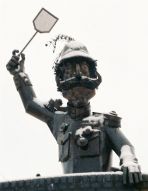- Platenboy
- Platen Punisher
 Offline
Offline 
- From: South Yorkshire, England
- Registered: 22-12-2014
- Posts: 54
Re: Backing sheets
I roll a very thin sheet of neoprene rubber into my machine and its like having a new platen, all you hear is the mechanics of the machine. Some machine don't like it and won't pull it through, the smaller the machine the less it likes it, my Olympia SM4 took it at first then the rubber stopped taking it so I thought I had better stop in case I was wrecking the machine. I think the big standards will take it fine. It really makes such a difference. I cut mine to A4 so it was easy to pop the paper I wanted to type on behind the A4 rubber and it winds through perfectly together. I couldn't tell you how thick it was but it appears to be about 1 mm thick.
- typeset
- Touch Typist
 Offline
Offline - Registered: 24-4-2016
- Posts: 182
Re: Backing sheets
I found this thread interesting, and came up with an alternative that has worked well for me: vellum sheets. I use the 29-pound version, which I find a bit thick. I've used it for several days, and a sheet lasts me at least several times. In fact, there are barely indentations on it after repeated uses.
Visit my website, eafeliupoetry.com, for posts on typewriters and literature.
- Uwe
- Moderator
 Offline
Offline 
- From: Toronto, Canada
- Registered: 12-3-2013
- Posts: 4,410
Re: Backing sheets
typeset wrote:
I found this thread interesting, and came up with an alternative that has worked well for me: vellum sheets. I use the 29-pound version, which I find a bit thick. I've used it for several days, and a sheet lasts me at least several times. In fact, there are barely indentations on it after repeated uses.
I assume you are using the plasticized kind and not natural vellum? I experimented with paper vellum once but for some reason was under the impression that it was fairly hard (not a good thing for type slugs - and maybe why impressions aren't being left on your backing sheet). I'll have to try and find the paper vellum I have and test it with my durometer to see what its actual effect is when used as a backing sheet.
The pronoun I has always been capitalized in the English language for more than 700 years.
- Repartee
- Key Master
 Offline
Offline 
- From: Brooklyn
- Registered: 12-10-2015
- Posts: 683
Re: Backing sheets
Considering that traditional vellum is parchment made from calfskin I would assume he using a modern product by that name! Using animal vellum for typewriter backings sheets is is something like putting gold leaf on ice cream. Which people have done!
I had a problem with furnace exhaust leaking into the basement so I put a fan in the window to exhaust it. It took a boiler tech to illustrate to me that understanding a principle is not the same as applying it to reality, when he pointed out that the exhaust fan was lowering air pressure in the basement and sucking more exhaust gas out, making the problem worse. Backing sheets are something like that since if the problem is that the type is being stopped by a hard platen and cutting the paper then raising the typing surface means the anvil has even less roll and even more of the impact of stopping the action is being absorbed by the type. Does not mean they should not be used but something to be aware of.
I have typewriters with hard platens that hardly need a backing sheet and do not punch through paper - because the type bars are stopped mainly by the anvil and not the paper. A 1926 Remington and a 1929 LC Smith do not have much problem using both sides of a sheet of paper while many later machines make the back of the paper look like a sheet of braille. A deliberate decision to use the platen to allow looser manufacturing tolerances?
"Damn the torpedoes! Four bells, Captain Drayton".
- retro
- Platen Punisher
 Offline
Offline 
- From: Suffolk, England
- Registered: 11-2-2015
- Posts: 66
Re: Backing sheets
I have never come across plastic backing sheets only ones made from cartridge thickness paper and they sometimes came with a pack of typing paper. I bought an Erika 105 which had been owned by someone who taught typing and there were a number of foolscap size backing sheets in the case pocket. They have a scale marked line spaces on the left and millimetres on the right below a dotted line that runs across the page half an inch from the top. I don't think I ever used a backing sheet when typing letters at work since it was usual practice to have two carbon copies only when it was not required to have carbon copies like when producing tabulations did we ever use a backing sheet. The backing sheets that came with the typewriter look a bit fiddly to use and I haven't tried one. I have always just used a normal letter quality thickness sheet for a backing sheet.
- TypewriterKing
- Inactive Account
 Offline
Offline - From: DeepInTheHeartO', Texas
- Registered: 17-2-2016
- Posts: 1,011
Re: Backing sheets
I don't recall if this issue has been addressed. While the main concern is using backing sheets to prevent punching holes in the paper in the process of typing, I have another concern to go along with this: Using backing sheets to cut down on the wear and tear of the typebar slugs. Constantly hitting a hard platen I would think would have a wearing effect on the typefaces--especially on letters most commonly used such as the letter e. Yes, I have machines that span the ages of about 55 to 105, and yes, though the platens are smooth, they are also hardened with age. To get all these recovered would take the amount of the National Debt to get done, if I were to take proper channels. But since I can't afford a flea a wrestling jacket just now, I use two sheets of regular paper along with the one I intend to transmit print upon, and I am working on being more ginger with the keys--kind of like driving a car being careful with the gas pedal to save fuel.
Underwood--Speeds the World's Bidness
- Pete E.
- Typewriter Talk Elite
 Offline
Offline 
- From: Idaho - USA
- Registered: 23-6-2020
- Posts: 2,537
Re: Backing sheets
I use a sheet of this stuff. Get it at Staples and/or on eBay.
The plastic side goes against my typing paper and the peel-off paper side goes against the platen.
Add a nice soft plastic buffer for hard platen rubber.
.


